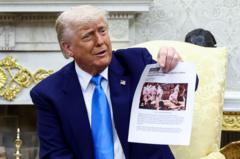In the midst of Donald Trump's presidency, foreign engagements often deviate into public displays, as observed during Trump's recent meeting with South African President Cyril Ramaphosa. This encounter highlighted a series of choreographed yet contentious exchanges. Initiated by a journalist's query regarding Trump's controversial assertions about "white genocide" in South Africa, the interaction quickly escalated.
With camera operators present, Ramaphosa emphasized the importance of listening to South African voices on this matter. In response, Trump directed aides to "turn the lights down," inciting an impromptu presentation filled with video clips and news articles that implied a violent agenda against white farmers in South Africa. Elon Musk, a prominent South African-born billionaire and Trump advisor, stood as a silent observer throughout.
The atmosphere reflected Trump's prior meetings with foreign leaders, showcasing his propensity for confrontation reminiscent of his interaction with Ukraine's Volodymyr Zelensky. The displayed footage included incendiary imagery of political figures chanting slogans associated with apartheid-era sentiments, underscoring Trump's unwavering focus on the alleged persecution of Afrikaners. However, Ramaphosa, prepared for the challenges of the meeting, rebutted Trump's assertions by clarifying that the South African political figures depicted in the footage lacked governmental authority over land confiscation.
Despite Trump’s determination to stir controversy, Ramaphosa kept calm, using strategic alliances to protect his position. He brought notable golf icons, Ernie Els and Retief Goosen, to aid his diplomatic stance, effectively crafting a barrier against Trump’s aggressive questioning. This unprecedented inclusion drew Trump's approval, momentarily directing attention away from political disputes.
Though Trump attempted to sway Ramaphosa towards addressing the plight of white farmers, his provocations were met with restrained responses. Ramaphosa cleverly noted that if genuine genocide were occurring, the wealthy farmers accompanying him wouldn't be present at the meeting.
Trump's theatrics, while not effectively provoking Ramaphosa, served a dual purpose: amplifying his message to a domestic audience and feeding into the grievances that galvanize his supporters. The meeting highlighted the need for both leaders to navigate the complexities of diplomacy while preserving their political narratives, hinting at an evolving dynamic that might require Trump to adjust his methods in future engagements.
With camera operators present, Ramaphosa emphasized the importance of listening to South African voices on this matter. In response, Trump directed aides to "turn the lights down," inciting an impromptu presentation filled with video clips and news articles that implied a violent agenda against white farmers in South Africa. Elon Musk, a prominent South African-born billionaire and Trump advisor, stood as a silent observer throughout.
The atmosphere reflected Trump's prior meetings with foreign leaders, showcasing his propensity for confrontation reminiscent of his interaction with Ukraine's Volodymyr Zelensky. The displayed footage included incendiary imagery of political figures chanting slogans associated with apartheid-era sentiments, underscoring Trump's unwavering focus on the alleged persecution of Afrikaners. However, Ramaphosa, prepared for the challenges of the meeting, rebutted Trump's assertions by clarifying that the South African political figures depicted in the footage lacked governmental authority over land confiscation.
Despite Trump’s determination to stir controversy, Ramaphosa kept calm, using strategic alliances to protect his position. He brought notable golf icons, Ernie Els and Retief Goosen, to aid his diplomatic stance, effectively crafting a barrier against Trump’s aggressive questioning. This unprecedented inclusion drew Trump's approval, momentarily directing attention away from political disputes.
Though Trump attempted to sway Ramaphosa towards addressing the plight of white farmers, his provocations were met with restrained responses. Ramaphosa cleverly noted that if genuine genocide were occurring, the wealthy farmers accompanying him wouldn't be present at the meeting.
Trump's theatrics, while not effectively provoking Ramaphosa, served a dual purpose: amplifying his message to a domestic audience and feeding into the grievances that galvanize his supporters. The meeting highlighted the need for both leaders to navigate the complexities of diplomacy while preserving their political narratives, hinting at an evolving dynamic that might require Trump to adjust his methods in future engagements.

















